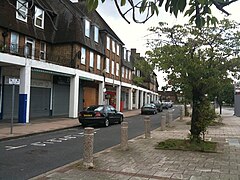St Helier, London
| St Helier | |
|---|---|
 Shops at Green Lane, St Helier |
|
| St Helier shown within Greater London | |
| Population | 11,949 (2011 Census Sutton Ward) 10,414 (2011 Census. Merton Ward) |
| OS grid reference | TQ265664 |
| London borough | |
| Ceremonial county | Greater London |
| Region | |
| Country | England |
| Sovereign state | United Kingdom |
| Post town | MORDEN |
| Postcode district | SM4 |
| Post town | CARSHALTON |
| Postcode district | SM5 |
| Dialling code | 020 |
| Police | Metropolitan |
| Fire | London |
| Ambulance | London |
| EU Parliament | London |
| UK Parliament | |
| London Assembly | |
St. Helier (/səntˈhɛliər/) is a residential cottage estate in the London boroughs of Merton and Sutton. The portion of the estate north of Green Lane and Bishopsford Road is in Merton, the rest is in Sutton.
The site of the St. Helier estate has been connected to long-term charity since the early 17th century. Henry Smith (d. 1627) was a wealthy citizen and salter of London who gave much money to parishes in London and Surrey during his lifetime and in his will. He is buried in Wandsworth parish church and is supposed to have been born in Wandsworth. In 1617 he gave £500 towards the purchase of land in Carshalton, the rent of which was to support the poor of Wandsworth. Another £100 bequest came from Mrs. Elizabeth Blackwell. In 1814 the lands were described as being just over 116 acres and having a building, barn and outhouses. The Wandsworth Poor Lands lay on either side of Wrythe Lane at the southernmost part of the St. Helier estate footprint. Another local benefactor was Christopher Muschamp, who died in 1660 and is buried at All Saints, Carshalton. He bequeathed £200 to buy land, the yearly rental of which was to purchase apprenticeships for two poor children who had been born in the parish. Pasture land was bought from Henry Byne in Cannon Sheephouse Lane, which is now known as Green Wrythe Lane. Like the adjoining Sutton Common, most of the area remained semi-rural until the early 20th century.
The estate was built between 1928 and 1936 by the London County Council for the re-housing of people from decaying inner London areas. Landscaping on the large-scale town planning scheme was by landscape architect Edward Prentice Mawson.
...
Wikipedia

